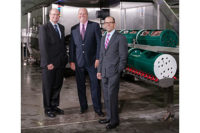Cover Story
West Liberty Foods: A meat-processing jackpot
West Liberty Foods won the meat-processing lottery in 2014, when it purchased the former Quantum Foods facility in Bolingbrook, Ill. — a jackpot that already has paid dividends and has an aggressive growth plan in place.

West Liberty Foods purchased the former Quantum Foods processing facilities in Bolingbrook, Ill. in the summer of 2014.



Flexibility in terms of customers served and product mix are of utmost importance to West Liberty Foods when discussing operations on steak-cutting lines.

After rearranging and repurposing some of the existing equipment in the facility, West Liberty Foods was able to create a new processing line to produce frozen chicken wings at the Bolingbrook facility, as seen here during The National Provisioner’s visit.

Gerald Lessard (right), vice president and COO of West Liberty Foods, shows Andy Hanacek and John Specht of The National Provisioner the culinary kitchen that the company purchased along with the Bolingbrook facility.






In January 2016, a jackpot of historic proportions grabbed the attention of the nation — those who purchased Powerball tickets hoped the record $1.58 billion prize would land in their laps and change their fortunes. Three winning tickets were sold, forever rewriting the future for those ticketholders.
In the summer of 2014, some may remember the meat industry’s parallel to this recent Powerball analogy: a coveted jackpot, albeit not a record-setter per se, available to one lucky winner. The pursuit and purchase of the former Quantum Foods processing facilities in Bolingbrook, Ill., was something the industry watched carefully, and it was an outcome that figured to change the outlook for one company forever. Indeed, the future for West Liberty Foods changed instantly that summer, when the purchase was closed and the company’s path forward turned dramatically.
Exclusive video Q&As
Andy Hanacek visited Liberty Cold's recently opened new cold storage complex and spoke with reps about the opening and new facility in these exclusive video interviews. |
“We made our first transition from being a turkey company to a meat company years prior,” says Ed Garrett, president and CEO of West Liberty Foods. “Now, we’re making another transition away from being known only as a meat-slicing company into a full foodservice, middle-tier restaurant/retail company that can offer multiple proteins and multiple products.”
Much has been reported on the rise and fall of Quantum Foods, but that’s old news now — and in the first half of 2014, West Liberty Foods was growing quickly, finding itself near capacity at its three processing plants in West Liberty and Mount Pleasant, Iowa, and Tremonton, Utah. In fact, the company didn’t have capacity or equipment to back up the Tremonton plant should a disaster halt production there.
“We either had sister plants or multiple lines where we could run similar product for all our facilities except Tremonton, so we knew we needed to do something there,” Garrett explains. “At the same time, we were about to release bids to build a culinary kitchen at the corporate office, to offer our customers [that R&D setting].”
It had become clear that West Liberty Foods would need to expand to meet these needs. The executive team was well aware of Quantum’s reputation as having built good facilities prior to its downfall, and after another company’s attempt to purchase them fell apart, the facilities were scheduled to hit the auction block. According to Garrett, that’s when the picture of what was available in Bolingbrook started to move more into focus.
“It was a good fit: It had the lines we needed, it got us into new product lines, and it has a great culinary, R&D area,” he says. “The only issue was, we only had about three weeks to get a deal done, because the auction was set for a specific date.”
Working with the bankruptcy court and creditors, West Liberty was able to complete the deal and had the keys to the facility within four weeks’ time, on June 24, 2014.
Calculated ramp-up
Once the deal was closed, West Liberty Foods could take a moment and breathe deeply — taking the time to assess the situation in Bolingbrook and start the facility up at a comfortable, measured pace.
“Some people might have said, ‘Let’s put this plant back together, get all of the lines running like they were, and then we’ll correct, fix and adjust as we go forward,’” Garrett says. “I looked at it differently and decided that we should pick a line, master it, know we have sales for it, then move to the next line and do the same thing.
“Even though I knew it would take about a year, and it might cost a bit more that way, I knew we could slowly introduce the way we do business to the team and perfect that product line before we moved on — it was a calculated slow start,” he adds. West Liberty Foods could afford to use this approach because the facility was in such solid shape when it was purchased. Gerald Lessard, vice president and COO, says the plant appeared to have been pretty well-maintained over the years, and the equipment was a “mixed bag” of relatively new and older equipment that was well-worn too.
“After we acquired the facility, we reached out to our vendors and suppliers, and we asked them to come in and provide assessments of the equipment,” he says. Additionally, the production plans were being drawn up, and once the company had decided on what it needed, it could combine those assessments with the outlook for the plant floor, and begin to really dig into what equipment was vital and what was less important.
Through that process, the company uncovered the fact that some of the technology built into a lot of the equipment hadn’t really been utilized to its full capability. That discovery alone has given West Liberty Foods a boost as it takes on some of these newer product lines.
“We’ve demonstrated that technology does enhance both the attributes and performance of the finished products during the manufacturing process,” Lessard says. Beyond taking advantage of the technology available, West Liberty Foods has been able to assemble its current processing lines nearly entirely from equipment on site at the time of purchase.
“Very little new equipment has come in; a lot of the existing equipment was repurposed with new layouts to make processes more efficient,” he explains. “The frozen wing line, for example, is essentially all repurposed and reconfigured equipment, with the exception of some of the conveyors.”
One room that combines new equipment with repurposed is the new high-pressure pasteurization (HPP) room in Bolingbrook. When West Liberty Foods acquired the former Quantum facilities, there was a pearl inside the leased distribution facility that the company wanted to keep: a relatively new HPP machine.
West Liberty Foods had 30 days to pack the equipment up and move it roughly four miles over industrial park roadways to get it across the interstate to the processing plant.
“We had to remove some walls at the distribution facility, load it up, put in new concrete floors here to support it, then reassemble it, and the team stepped up to make it happen,” Lessard says. During this project, West Liberty Foods opted to pour concrete floors for and install a second HPP unit, and the room has been operating since January 2015. At presstime at the end of 2015, Lessard says all five HPP units in the company have reached 100 percent utilization.
Beefing things up
Possibly the biggest alteration to West Liberty Foods’ future, however, was the addition of the steak-cutting lines to the company’s roster. This new opportunity excites Garrett, and he says it has “changed the face of the company.”
“There are things we can do here that we’ve never been able to do before, and it’s already paying dividends; we’re seeing new customers in a new customer base, and we’re excited to be presenting new items to new people,” he adds. “Right now, we’re starting a business that we know we can compete in and teach our people to raise the bar.”
In July 2015, West Liberty Foods hired Ed Ligas, who with his family founded Stampede Meat in Bridgeview, Ill., and carries a fantastic resume with him in this field. Ligas, who is now West Liberty Foods’ vice president of Beef Operation, was up front with the company from the start on his own goals for the role he now fills.
“I said that I didn’t just want a job, I want to build something — take something and build a business out of it,” he says. “And what I liked about West Liberty Foods was, I wanted someone with an entrepreneurial spirit that really wanted to grow, and I was excited that I would have an opportunity to work with other products that I didn’t make while I was at Stampede: some of the par-fry, in-line cook items.”
Once Ligas walked in the door of the cutting room, things began to really move, with the goal of becoming more flexible in terms of the capabilities of the beef operation.
“Because Quantum had been a mature business for 15-20 years or so, it was set up to run extremely large volumes of certain products, so we realigned rooms and production lines, such that we had a good assortment of products we could run, various cuts and things like that,” he says. “The biggest initial challenge was getting things moved, utilities run, tested, replaced or modified to suit the new needs of the facility, and then preparing the facility and paperwork for the USDA.”
Ligas and Dr. Lee Johnson, vice president of Technical Services for West Liberty Foods, worked together to develop and install a spray intervention for all products in the room, as well as a test-and-hold policy on
E. coli to ensure food safety.
He reiterates that a broad base of capabilities will help not only on the customer side, through which the company can utilize its assets more efficiently while offering more products to individual customers, but also on the supplier side.
“By having multiple proteins, or multiple cuts for the beef operation, we become more important to our raw-materials suppliers because we’re not just buying short loin; we’re buying ball tips, flats, skirts, clod hearts, you name it,” he says. “That also helps us spread our cost risk a little better, so we’re not living and dying by, say, the market for briskets.”
Ligas says that his employees already have gotten used to the fact that they could be cutting something different each day, and he appreciates their flexibility.
“I’m most happy about my people, because they just get it,” he explains. “I actually gave them a speech during training a week before we started and told them to be ready to be flexible, because we’re going to need you to produce a lot of different items.”
Capabilities-wise, Ligas says West Liberty Foods is in great shape, showing off a list of dozens of cuts and products available to customers. It’s simply a matter of spreading the word, getting orders and meeting the demands of a market segment that he believes hasn’t had a dominant player since Quantum Foods folded.
“I’m used to what I call the 900-pound-gorilla customers, your large-chain retail and foodservice accounts, and that’s what we’re going to go after,” he says. “This plant can produce a ridiculous amount of volume, and it may take a little bit of time, but it’ll be a focused attempt to get a broad base of customers and products in a controlled manner where we don’t outgrow our systems,” Ligas says. “The beautiful part for West Liberty is: The systems are already here, we just have to fill them.” NP
Looking for a reprint of this article?
From high-res PDFs to custom plaques, order your copy today!











